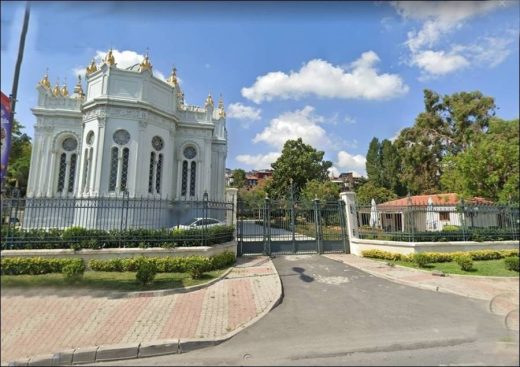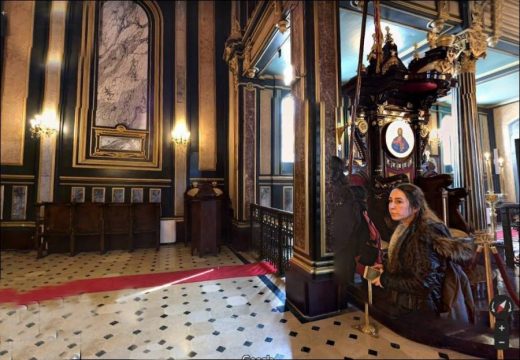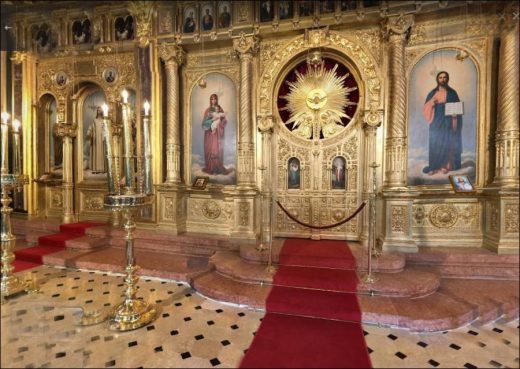We are in Istanbul, Turkey’s largest city. Sveti Stefan Bulgarian Church, with its greenish gray tones and strikingly different architecture, on the Fener – Balat road on the shore of the Golden Horn, is like a symbol of the independence of a nation. The church, which is the first example in world architecture in terms of its construction, watches Istanbul against the Golden Horn, on its shoulders the burden of a whole history it has witnessed.
The Ottoman Empire, which was a huge empire with its minorities in the 1800s, began to be shaken by the influence of the nationalism movement. Just at this time, the sultan was faced with the Bulgarians’ offer to establish a separate independent church. The Bulgarian minorities, which are essentially affiliated with the Greek Orthodox Church, are uncomfortable with the fact that the worship is performed in Greek.
Having built a wooden church in the house that Prince Sveti Bogardi had given them as a gift, Bulgarians asked permission from the sultan of the period, Abdülaziz, with the idea of building their own Orthodox church. Considering both the nationalist movement of the time and the relations and agreements he established with the Greek Patriarchate, the sultan replied to the Bulgarians with a unique style: “If it will be done in a month, don’t stop!”.
On top of that, since it would take time to reconstruct the church here, the Bulgarians broke new ground in the history of world architecture with their ideas. In line with the project of the architect Hovsep Aznavur, all the materials of the church, which is made of cast iron, are prepared in Vienna. In fact, an international competition is held for the construction of these prefabricated materials and an Austrian company Wagner is brought to the head of the project.
After the intense and tiring work, the church is first set up in the garden of the factory in Vienna for trial purposes, then the parts are dismantled and the Black Sea journey over the Danube. Thus, the Bulgarian Church, which reflects the neo-gothic style and the eclectic (elective) understanding frequently encountered in Europe of the period, takes its place in the pages of history as the first prefabricated church in architecture.
In memory of Saint Stefan
The church, which was opened for worship by Ekzarh Yosif in 1898, was dedicated to St. Stefan. St. Stephen, the first person to accept Christianity after the apostles, was sentenced to death by the Jerusalem Court on the grounds that he insulted Prophet Moses after a speech he made to spread the religion. St. Stefan, who was stoned to death, is also considered the first victim of religion. Inside the church, it is possible to see the relief of St. Stefan, depicted with a stone in his left hand.
Metoh – Priest House
Shortly after its opening, a priest’s house, called “metoh” in Bulgarian, was built opposite the church for the priests and church officials to stay. The Bulgarians, who also have an independent Orthodox Church, change the title of their community leaders to “Exarch”. In the Orthodox Church hierarchy, the Exarchate, which is a rank lower than the patriarch and higher than the metropolitan, officially recognized this autonomous church in the Fener Greek Patriarchate.
In a quiet world you can
Sveti Stefan Bulgarian Church, which has lived through nice times and witnessed the birth of a new state after the collapse of the empire, is smiling sadly with its tired body. With the decline of Bulgarian minorities, the church opens its doors only on holidays. In his garden, it is impossible to see anyone other than Vasil Bey, the veteran bell ringer and church caretaker, and a few of his friends. It is not known whether the Bulgarian Church, which has managed to emerge victorious from fires and wars for centuries, will also withstand this gnawing loneliness in the same way. However, it is a fact that the church has suffered serious damage and is on the verge of collapse.
The biggest hit of the Bulgarian Church is that its foundation is built on wooden piles. The purpose of this choice, which seemed like the right choice at the time it was made, was that the boards swelled as the water got in and they were able to carry the church. However, the relocation of the Golden Horn bridge caused a decrease in water circulation, and the boards that could not get enough water and inflated were insufficient to carry the church. The reason is that the historical church is taking one more step towards the Golden Horn every year…
On the threshold of a goodbye
The church, which suffered its first damage fifteen years after its construction, overflowed and flooded the land in the direction of the Golden Horn.
The first repairs to the church were made in 1946. The tombs of the clergy in the courtyard were made concrete, the windows and “iconostasis” were painted.
In 1988, Austrian engineer Gilbert Wiplinger filed a damage report on the church, but a second restoration of the decaying architecture was only possible three years later.
In 1991, ITU Faculty of Architecture lecturer Prof.Dr.Mete Tapan and Master Architect Prof.Dr. The damage report prepared by Hasan Kuruyazıcı showed that the situation was getting worse. The foundation of the church was settled, a part of the building shifted towards the Golden Horn, and as a result of the rising and lowering of the water level, the basement began to flood from time to time. In short, the Bulgarian Church was on the verge of a farewell.
Taking the report into account, repair works were started immediately. The outer wall covering plates of the church that rotted and torn as a result of corrosion were renewed, the marble steps that were displaced were fixed, the broken and collapsed marble slabs were repaired and some were replaced with new ones. However, no precaution has been taken to prevent settlement at the foundation.
Recently, it was stated that the columns of the church began to separate from each other. The alarm bells of the historical Bulgarian Church in Kisacasi are still ringing. So much so that Prof. According to Mete Tapan, since the church is in an earthquake zone and can be affected by even a small earthquake, large trucks should not pass through the coastal road if possible.
Well, are we going to watch the collapse of history in plain sight? Will the Golden Horn lose its friend who greets him at sunrise? The Chairman of the Board of the Bulgarian Orthodox Churches Foundation, Georgi Kostandov, states that the necessary applications and procedures will be made within the framework of a cooperation agreement signed by the Turkish-Bulgarian ministries of culture.
Towards lightness
The historical Sveti Stefan Bulgarian Church is among the beneficiaries of the Fener-Balat Rehabilitation Project… As the second church to be illuminated after Saint Antoine, the Bulgarian Church is preparing to shine a divine light in the silent world of darkness.
Concerts to be given by world-renowned ensembles in the church, which is trying to prove once again that it is the pearl of the Golden Horn, are also a harbinger of rebirth.
The classical music concert, which will be given by Harmanic Brass, Europe’s major woodwind ensemble, on June 10, aims to bring a smile to the face of the Sveti Stefan Church by reuniting visitors. Hermanic Brass group, which has an understanding of building bridges between periods and cultures, is also appreciated by people with its refined interpretations.
With the concert that will take place this month, we hope that we can restore that colorful splendor to the resentful Sveti Stefan Church.
Views: 187





